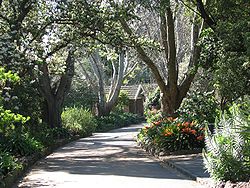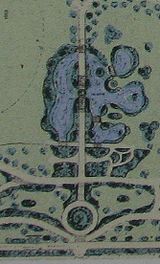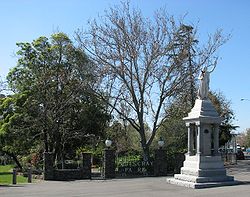
Footscray Park
Encyclopedia

Edwardian period
The Edwardian era or Edwardian period in the United Kingdom is the period covering the reign of King Edward VII, 1901 to 1910.The death of Queen Victoria in January 1901 and the succession of her son Edward marked the end of the Victorian era...
park
Park
A park is a protected area, in its natural or semi-natural state, or planted, and set aside for human recreation and enjoyment, or for the protection of wildlife or natural habitats. It may consist of rocks, soil, water, flora and fauna and grass areas. Many parks are legally protected by...
in Australia
Australia
Australia , officially the Commonwealth of Australia, is a country in the Southern Hemisphere comprising the mainland of the Australian continent, the island of Tasmania, and numerous smaller islands in the Indian and Pacific Oceans. It is the world's sixth-largest country by total area...
. The 15 hectare park is located on the south bank of the Maribyrnong River
Maribyrnong river
The Maribyrnong River rises about 50 km north of Melbourne, Victoria , near Mount Macedon. It flows generally southward and combines with the Yarra River to flow into Port Phillip....
in Footscray
Footscray, Victoria
Footscray is a suburb 5 km west of Melbourne, Victoria, Australia. Its Local Government Area is the City of Maribyrnong. At the 2006 Census, Footscray had a population of 11,401....
in Victoria
Victoria (Australia)
Victoria is the second most populous state in Australia. Geographically the smallest mainland state, Victoria is bordered by New South Wales, South Australia, and Tasmania on Boundary Islet to the north, west and south respectively....
. It is classified as a heritage place on the Victorian Heritage Register
Victorian Heritage Register
The Victorian Heritage Register lists places of cultural heritage significance to the State of Victoria, Australia. It has statutory weight under the Heritage Act 1995 which establishes Heritage Victoria as the permit authority...
for its aesthetic, horticultural and social significance to the State of Victoria and was the first gardens to be placed on the register. The park is noted for its botanical collection, ornamental ponds and garden structures.
History

Boy Scout
A Scout is a boy or a girl, usually 11 to 18 years of age, participating in the worldwide Scouting movement. Because of the large age and development span, many Scouting associations have split this age group into a junior and a senior section...
s. By 1914 the park already had a large collection of Australian native species, predominantly Eucalyptus
Eucalyptus
Eucalyptus is a diverse genus of flowering trees in the myrtle family, Myrtaceae. Members of the genus dominate the tree flora of Australia...
and Acacia
Acacia
Acacia is a genus of shrubs and trees belonging to the subfamily Mimosoideae of the family Fabaceae, first described in Africa by the Swedish botanist Carl Linnaeus in 1773. Many non-Australian species tend to be thorny, whereas the majority of Australian acacias are not...
s. Many of the gardens structures including arbours, bridges and ponds were constructed by unemployed Victorians during the Depression. The majority of the layout and installation of features was carried out under the direction of David Mathews who was Superintendent of Parks and Gardens for the City of Footscray between 1916 and 1964. William Nicholls, an orchid specialist, also assisted in the task.
The slopes of the park were a vantage point for a crowd of 40,000 to see Bert Hinkler
Bert Hinkler
Herbert John Louis Hinkler AFC DSM , better known as Bert Hinkler, was a pioneer Australian aviator and inventor. He designed and built early aircraft before being the first person to fly solo from England to Australia, and the first person to fly solo across the Southern Atlantic Ocean...
land his plane at Flemington Racecourse
Flemington Racecourse
Flemington Racecourse is a major horse racing venue located in Melbourne, Victoria, Australia. It is most notable for hosting the Melbourne Cup, which is Australia's richest horse race. The racecourse is situated on low alluvial flats, next to the Maribyrnong River...
in 1928 as part of an Australian tour following his successful completion of the first solo flight from England to Australia. The park has been the venue for two large Melbourne events - The Saltwater Festival and the Vietnamese Festival.
Park layout and features

World War I
World War I , which was predominantly called the World War or the Great War from its occurrence until 1939, and the First World War or World War I thereafter, was a major war centred in Europe that began on 28 July 1914 and lasted until 11 November 1918...
memorial which was unveiled in 1922 stands at the entranceway. It features an Italian-sculpted marble statue of Victory
Victoria (mythology)
In ancient Roman religion, Victoria was the personified goddess of victory. She is the Roman equivalent of the Greek goddess Nike, and was associated with Bellona. She was adapted from the Sabine agricultural goddess Vacuna and had a temple on the Palatine Hill...
on a granite base.
A rustic stone columned lookout shelter and pergola which was designed and built by students from Footscray Technical School in 1928 has a view toward the Maribyrnong River and Flemington Racecourse
Flemington Racecourse
Flemington Racecourse is a major horse racing venue located in Melbourne, Victoria, Australia. It is most notable for hosting the Melbourne Cup, which is Australia's richest horse race. The racecourse is situated on low alluvial flats, next to the Maribyrnong River...
. Nearby a mounted bust of Henry Lawson
Henry Lawson
Henry Lawson was an Australian writer and poet. Along with his contemporary Banjo Paterson, Lawson is among the best-known Australian poets and fiction writers of the colonial period and is often called Australia's "greatest writer"...
honours the Australian poet and writer and the inaugural Henry Lawson Literary Society commemorative event held in the park.
The park has two (originally three) major paths running east-west along the embankment which are bisected by a north-south path (the T.B. Drew Memorial Walk) which descends the embankment through a wisteria-covered arbour to Thomson Water Garden.
The Alfred Green Memorial Fountain (locally known as the “platypus fountain”)
is an unusual granite fountain that is supported at its base by two sculpted platypus.
The park also has open playing fields on the flat area near the river.
Trees
The park has a diverse collection of mature trees, including palms, elms, ash, oaks, cypress, various Australian species as well as a number of species which are rare in cultivation in Australia. The following trees are cited in its heritage listing:- Brahea armataBrahea armataBrahea armata, commonly known as Mexican blue palm or "blue hesper palm", is a palm is native to Baja California. It is widely planted as an ornamental....
( Blue Hesper Palm) - Clerodendrum glabrumClerodendrum glabrumClerodendrum glabrum is a small to medium deciduous tree, widespread from Tropical to Southern Africa.In common with others of this family, its bark is covered in prominent white lenticels. Leaves are usually in whorls of 3 and produce a fetid smell when crushed...
(2 trees) - Cupressus macrocarpaCupressus macrocarpaCupressus macrocarpa, commonly known as Monterey Cypress or Macrocarpa, is a species of cypress that is endemic to the Central Coast of California. In the wild, the species is confined to two small populations, near Monterey and Carmel, California. These two small populations represent what was...
'Hodginsii' - Ficus microcarpaFicus microcarpaFicus microcarpa, also known as Chinese Banyan, Malayan Banyan, Indian Laurel or Curtain fig, is a banyan native in the range from Sri Lanka to India, southern China, the Malay Archipelago, the Ryukyu Islands, Australia, and New Caledonia.-Taxonomy:Hill's Weeping Fig is a form of Ficus microcarpa...
var. hillii (Hill's Fig) - Melaleuca halmaturorumMelaleuca halmaturorumMelaleuca halmaturorum, known as Swamp Paperbark , is a native tree of Western Australia....
- Quercus aff. stellata
- Vitex agnus-castusVitex agnus-castusVitex agnus-castus, also called Vitex, Chaste Tree, Chasteberry, Abraham's Balm or Monk's Pepper, is a native of the Mediterranean region. It is one of the few temperate-zone species of Vitex, which is on the whole a genus of tropical and sub-tropical flowering plants...
- Ulmus glabra 'Exoniensis'Ulmus glabra 'Exoniensis'Ulmus glabra Exoniensis, the Exeter Elm, was discovered near Exeter, England, in 1826, and propagated by the Ford nursery in that city. Its fastigiate shape when young, upward-curving tracery, small samarae and leaves, late leaf-flush and late leaf-fall, taken with its south-west England...
(Exeter Elm)

